Blueprinting: The structural repair tool your shop is missing
Content brought to you by Auto Body Repair Network. To subscribe, click here.
What you'll learn:
- Blueprinting allows shops to plan for repairs accurately
- Blueprinting helps us pinpoint which of the three types of alignment a vehicle may need: structural alignment, wheel alignment, and ADAS sensor placement and calibration
- Blueprinting should be treated as your trusted partner that guarantees accuracy and efficiency in every repair
Technicians can’t look at today’s vehicles the same way they did 10 years ago. Crucial safety improvements, structural reinforcements and luxury updates to modern vehicles have changed the way we address structural repair in our shops.
As shop owners and managers, business profitability and project cycle times are always top of mind. Although a core piece of our business performance, there’s something to be said about the requirements in keeping up with the new normal of vehicle production. Vehicles are now built to exact specifications. And with that, our focus has swiftly moved to the quality of work we’re doing rather than the time it takes to do it. That doesn’t mean quality hasn’t been a focus of ours. It’s that our process has historically allowed us to take a “copy-and-paste" approach, so to speak, in a vehicle’s structural repair. It was a process that worked, kept shops moving and customers happy. Except today, that isn’t the case.
Long gone are the days of only needing quick visual inspections. As we say hello to a new way of vehicle repair, we also welcome new tools and methods to help us stay on course. To improve overall efficiency, your shop must create a repeatable proven process that works, no matter the vehicle’s makeup. This process is known in the collision repair world as blueprinting.
Blueprinting and why it’s important
Blueprinting has become a popular buzzword throughout the industry. It addresses the important (and sometimes overwhelming) piece of creating a vehicle repair plan by establishing a standard operating procedure (SOP). It includes a thorough discovery to learn the history of the vehicle, what occurred in the accident and shares the total repairs needed to ensure a quality repair. This is a crucial step that is well worth your team’s time.
The goal of blueprinting is that it works with you, not against you. However, most still tend to overlook the benefits blueprinting can bring to their shop. In a presumably post-pandemic time, we are faced with serious issues regarding the supply and demand of essential repair parts. Blueprinting allows shops to plan for repairs accurately. Creating a strong process that identifies all the needed parts before beginning repair helps your shop mitigate risk, optimize quality improvement, and keep jobs on schedule.
Blueprinting also helps shops perform better diagnostic inspections to identify which ADAS repairs and calibrations may be required. With the changes in vehicle technology (specifically, ADAS), understanding the structural damage in each repair is critical. Blueprinting helps us pinpoint which of the three types of alignment a vehicle may need: structural alignment, wheel alignment, and ADAS sensor placement and calibration. If any of these alignments are not properly addressed, the vehicle cannot be accurately fixed.
It’s clear that blueprinting is a requirement for success. So why are shops still hesitant?
It’s hard to get past the fact that blueprinting is still yet another tedious step in the structural repair process. The two other notable hurdles shops face are simply getting started and having your entire team on board with this newly established process. At Chief Collision Technology, we have worked to ease this seemingly overwhelming headache by identifying the four main steps in creating a structural repair blueprint that’s guaranteed to eliminate inefficiencies and create a continuous workflow in your shop. These steps can be applied to any vehicle repair:
- Use collision dynamics to understand the relationship of the forces involved in the collision.
- Tear down and measure the vehicle to reveal hidden frame and structural damage not seen by the naked eye.
- List all parts, materials and operations required to fully repair the vehicle to ensure it performs correctly and drives safely. This step determines which areas need repair vs. replacement.
- And finally, write out your repair plan.
With updates constantly being made to vehicles, these steps serve as your guide in creating an airtight repair plan for each vehicle in your shop. If still overwhelming, remember to reflect on your shop’s overarching goals: to increase cycle time, improve customer satisfaction and enhance productivity. Blueprinting should be treated as your trusted partner that guarantees accuracy and efficiency in every repair.
Invest for accuracy and efficiency (and in your technicians, too)
Contrary to popular belief, blueprinting doesn’t require a “break the bank” investment for your facility. You will quickly find that spending a little money upfront on training can really go a long way. However, when you intertwine that comprehensive training with a few pieces of equipment that are solely focused on blueprinting and estimating, you have the chance to bring back some serious ROI to your shop.
The first step in accurately repairing a vehicle is to establish a solid foundation. To us, that means having the correct frame rack and anchoring system in your shop. Having the correct system prevents undamaged parts from shifting out of place during sectioning and helps to precisely distribute pressure when pulling is needed. In addition, by securely anchoring the vehicle to the frame rack, you prevent flex during pulling – which could further damage the vehicle. Once a proper foundation is set, you can start researching structural measuring tools that help identify the vehicle’s major (and minor) repair needs.
We know that vehicles with previous collision damage, more times than not, still have some level of structural damage, even after repair. That’s why all-encompassing systems like Chief’s Meridian Live Mapping provide a 360-degree view of all possible collision damage. This timesaving tool creates a comprehensive damage report – one that is crucial when developing the repair plan for each vehicle. It works alongside your technician who is conducting a visual inspection of the vehicle and paints a clear picture to your customers (and more notably, their insurance company) on the exact damages that exist – both seen and unseen. By harnessing the power of your in-house expertise and innovative scanning technology, you can identify and seamlessly document the damaged areas – making it easier than ever to justify your repair plan blueprint and allowing more time for your team to focus on what they do best: repairing.
Now that we’ve completed a full mapping of the vehicle and all are in alignment with the repair blueprint, your team can begin the disassembly for repair (DFR) process. These especially skilled technicians are responsible for repairing vehicles back to its original state. They work to completely disassemble the damaged area identified in the repair plan to gain visual access of the areas in need of repair. If done correctly, the benefits of blueprinting come to life here by saving you time and money. Your blueprint tells them exactly what tools are required and clearly outlines their next steps.
As the ones ensuring a quality repair, your technicians play a crucial role in your shop’s reputation. If your shop gains momentum in being known to produce high-quality repairs, your business grows. It follows that ensuring a talented and happy staff is essential. For us, we know that a well-paid tech is a happy tech… and a happy tech can support high levels of quality vehicle repair and customer satisfaction. As a contributor to the growth of a business, a question commonly asked is how the industry should properly compensate a disassembly technician. At Chief, we have seen many ways throughout the industry in how shops have implemented their compensation method. Some offer a base salary plus commission, some work through a flat rate per hour, while others have found success by offering a flat rate salary. Shops find the most success in embracing a trial-and-error approach. See what works and keep it. See what doesn’t and change accordingly. Each compensation system has its pros and cons. Ultimately, you need to make the best decision for your shop.
As vehicles continue to evolve, your shop must too. Blueprinting in structural repair allows you to put your best foot forward to increase productivity and get the vehicles in your shop safely back on the road. To get your shop laser-focused on accuracy, download our comprehensive Collision Repair Measurement Guide: https://chieftechnology.com/lp/blueprinting-measurement-equipment-guide/
About the Author
Mike Croker
Mike Croker is the director of product management at Chief Collision Technology. He is a devoted advisor for various technical school organizations and a national technical committee member with SkillsUSA. Mike uses a hands-on approach in training to serve as an I-CAR instructor and is an ASE subject matter expert for Structural Analysis and Damage Repair. For more information, visit www.chieftechnology.com or email him at [email protected].

